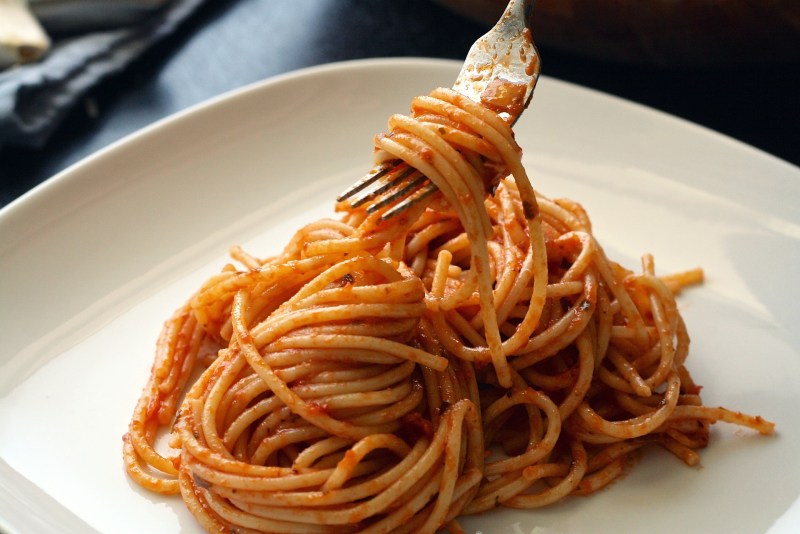Pasta and rice are both healthy sources of carbohydrates, which create most of the energy for your body. They can both be either better or worse, depending on your choices, and they’re both easy to use in a variety of dishes and culinary styles.
So, which should you choose? Is pasta or rice better for you? I personally am a fan of both, but whether I am in a bulking or cutting phase on my fitness journey, the one I reach for differs.
In this article, we’ll break down the nutritional benefits of each one, find out which is better, and advise you on how to add it to your diet. So, let’s get started!
Nutritional value of pasta

One hundred grams of cooked pasta contains 25 grams of carbohydrates and 5 grams of protein. It also contains 1 mg of iron, 6 mg of calcium, and small fractions of a wide variety of other vitamins and minerals.
While this nutrient information pertains to pasta in general, keep in mind that whole wheat pasta is a healthier option than refined pasta, as they have higher concentrations of vitamins and minerals.
What are the benefits of eating pasta?

Pasta is a good source of carbohydrates, which is where your body gets its energy. Whole wheat pasta is better since it has more complex carbohydrates, which give you longer-lasting energy. Studies have shown that having extra carbohydrates will “postpone fatigue… up to 20% in endurance events lasting more than 90 minutes,” so these are key nutrients for athletes.
Pasta contains a lot of minerals and some vitamins; it’s a good source of iron, especially if it’s whole-grain and enriched. It’s also known to be a warm and comforting meal — in fact, it’s been scientifically proven that eating pasta makes you happy. That doesn’t sound like a health benefit until you remember that stress and negative feelings can seriously impact your health, and things that are comforting and relaxing can actually improve your health.
Nutritional value of rice

The nutritional value depends on the type of rice. One hundred-gram servings of both brown and white rice contain about 80 grams of carbs, 3 grams of fiber, and 7 grams of protein. However, brown rice does have many more vitamins and minerals than white.
One hundred grams of white rice contains 26.5 mg of magnesium, 82 mg of potassium, and 1.5 mg of niacin, a B vitamin, plus a few less important vitamins and minerals. Brown rice has 115 mg of magnesium, 250 mg of potassium, and 6 mg of niacin, plus minor quantities of several other B vitamins.
What are the benefits of eating rice?

Rice is a good source of carbohydrates, which can give you energy throughout the day. Also, rice has more carbohydrates, and therefore more energy, than pasta. It’s cheap and easy to cook, and it contains some important vitamins and minerals, although brown rice has many more of those than white.
Is pasta or rice better for you?

Overall, it depends on what you’re looking for. Rice has a higher amount of healthy carbohydrates, which will give you more energy, but if you’re trying to cut carbs, pasta would be better. On the other hand, pasta sauce can often be sugary or even have additional starch and carbs, which makes pasta a worse option overall.
Pasta has higher concentrations of iron and calcium and a greater variety of vitamins in small quantities. However, rice has more of some other minerals, like magnesium, calcium, and phosphorus. It’s also easier to cook. Overall, rice is usually a better choice for most people.
How to implement rice into your diet

Rice is very easy to cook. On the stove, add twice as much water as rice, set it to simmer, and leave it covered… and, basically, don’t do anything until all the water is gone. I usually set a timer for ten-minute intervals, going down to five minutes when almost all the water is gone. Leave it to steam with the heat turned off for ten minutes, and then fluff with a fork.
There are dozens of ways to eat rice. Combine it with stir-fries, make fried rice, throw it into soup, grind it into flour (or buy rice flour), make risotto, or make your own rice cakes. You can even make your own rice crispy treats, although, at that point, you can’t really argue there’s much health benefit.
Frequently asked questions

Is rice or pasta better for weight loss?
Both rice and pasta can be part of a weight-loss diet. Rice is usually better since it contains more nutrients and doesn’t come with sauce by default, but you can eat either or both in moderation.
Is pasta good or bad for weight loss?
Whole-wheat pasta can be a good source of energy that lasts for a while, and it can be combined with meat and vegetables for a healthy and filling meal. Refined-grain pasta with sugared sauce, on the other hand, is probably bad for weight loss.
Why do bodybuilders eat rice instead of pasta?
Rice has more carbohydrates and more protein than pasta, which makes it a better source of nutrients. It’s also very cheap, and that can be important if you’re carb-loading or bulking and trying to get a lot of calories.




